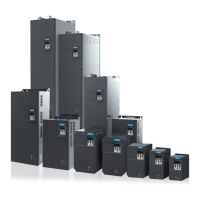
Do you have a question about the Inovance MD500T75GB-INT and is the answer not in the manual?
| Model | MD500T75GB-INT |
|---|---|
| Output Power | 75kW |
| Output Current | 150A |
| Cooling Method | Forced air cooling |
| Storage Temperature | -20°C to +60°C |
| Input Voltage | 380-480V AC |
| Communication Ports | Ethernet |
| Voltage | 380-480V AC |
| Control Mode | V/F control |
| Protection Features | Overcurrent, Overvoltage, Undervoltage, Overheat, Overload, Short circuit |
| Operating Temperature | -10°C to +50°C |
| Humidity | 5% to 95% RH, non-condensing |
| Altitude | Below 1000m (Derating may apply above 1000m) |
Identifies important characteristics and specifications for each model in the drive system range.
Specifies requirements for the working environment, cooling, ventilation, and mounting location.
Outlines the procedures for backplate mounting and through-hole mounting of the AC drive.
Illustrates the typical system connection diagram for the AC drive, including power and control circuits.
Details the main circuit terminals, their arrangements, and recommended cable dimensions and tightening torque.
Describes the control circuit terminals, their functions, and wiring diagrams for various signals.
Explains the three methods for controlling the AC drive's start and stop commands.
Details the four methods for setting the AC drive's frequency reference.
Describes the different start modes and stop modes available for the AC drive.
Explains how to obtain motor parameters through static and dynamic auto-tuning methods.
Details various protection functions for the AC drive and motor, including overload and phase loss.
Lists daily inspection items and solutions to ensure proper performance and product life.
Provides critical safety information related to troubleshooting and maintenance procedures.
Offers solutions for common problems encountered during initial trial runs of the AC drive.
Provides a table to troubleshoot faults by identifying causes and suggesting possible solutions.
Lists standard parameters with their numbers, names, setting ranges, defaults, properties, and page references.












